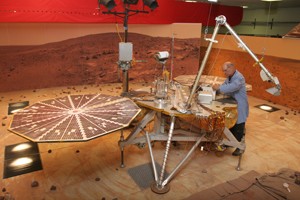Rick McCloskey, a mission engineer for the UA-led Phoenix Lander, grabbed a knee-length sky blue lab coat from a rack in his computer lab without so much as looking. Lab coats are part of the routine. It all had to do with ESD, he said. Then he paused.
“”Electrostatic discharges,”” he added. “”From your street clothes.”” Static built up on clothing could interfere with the mission’s electronics, McCloskey said.
Then McCloskey stepped out of the lab and onto the surface of “”Mars.””
McCloskey works on the mission’s Payload Interoperability Testbed. The PIT, as it is called, centers around a full-scale working model of ‘Phoenix’ that sits on a mock-up landing site complete with red “”Martian”” rocks.
This working model is the closest anyone will get to the ‘Phoenix’ mission, and it allows engineers to test maneuvers on Earth before they are ever attempted on Mars. Every instrument onboard the model works exactly the same as its counterpart on Mars, McCloskey said.
“”Having (the PIT) there with a working spacecraft – that’s been the great success story here,”” said Michael Drake, director of the UA’s Lunar and Planetary Laboratory, whose scientists are leading the NASA mission.
So the Red Planet is home to ‘Phoenix,’ but the UA has its twin sibling.
Except for the blue lab coat, McCloskey looked like he might be giving a tour of a B-movie set as he stepped onto the stage with the twin ‘Phoenix.’ Behind him, the Martian hills roll off into the distance in a huge photographic color backdrop.
The rock-strewn ground beneath McCloskey’s feet is rust tinted. Trenches are scraped into a sandy pit where ‘Phoenix’ has practiced flexing its robotic arm.
‘Phoenix’ itself is sprawled out in the center like a silver and gold butterfly mangled by a giant flyswatter. It is 14 feet across with solar panel “”wings”” outstretched.
All manner of gizmos jut haphazardly up from its abdomen. Shiny wire entrails droop just below its instrument decks. Its stocky lander legs and parts covered in what looks like gold tin foil scream 1960’s science fictionð – as if it were ripped out of the television show “”Lost in Space.””
But the PIT isn’t science fiction. It helps scientists to plan their daily activities on Mars, solve problems they encounter there and otherwise better explore the strange new world.
It allows mission engineers and scientists to not only test if the lander’s instruments work, but whether or not they will work well together. McCloskey said.
“”That’s our job – to test the interoperability of these instruments,”” he said. “”Do they play well together?””
The engineering model is host to an alphabet soup of scientific instruments: the Thermal and Evolved Gas Analyzer (TEGA), the Microscopy, Electrochemistry, and Conductivity Analyzer (MECA) and the Surface Stereoscopic Imager (SSI), just to name a few.
“”NASA loves acronyms,”” Drake said. “”NASA itself is an acronym.””
The PIT’s job is to make sure those acronyms work together.
“”The Robotic Arm, for example, has to be able to tell the MECA, ‘Here’s your soil. Are you ready for it?’ And MECA has to say, ‘Yeah, I’m ready for it,'”” McCloskey explained.
As the mission continues, team members try as closely as possible to duplicate the conditions found on Mars so instrument sequences can be practiced on Earth first. This goes all the way to replacing their panoramic backdrop with actual pictures taken by the lander. Or they might place rocks in the positions in which they find them on Mars.
Stage lights help simulate the time of day when maneuvers are performed. A large ultraviolet lamp stands in for the sun itself, because the lander’s cameras need UV light to focus correctly, said PIT team member Evan McKelvy, a mechanical engineering senior.
The time of day is important, because the twin landers’ onboard cameras send pictures to the PIT team of what their model is doing in the testbed. Even though team members can clearly see that an operation might be working on Earth, scientists must examine Mars pictures to tell if something is working.
‘Phoenix’ takes pictures during important moments of an operation to confirm that it is actually doing what it says it is doing. Because the pictures are so vital, everything about the tests should be as similar as possible to what is happening on Mars, right down to the shadows, McKelvy said.
“”That gives them a better idea of what to expect,”” he said.
The PIT is helping the UA to push the envelope of space exploration by allowing scientists to tackle problems on another planet, Drake said.
“”You must expect to have problems when you land on an alien body,”” he said. “”But we’ve actually been able to solve those problems by being able to practice here on Earth.””









